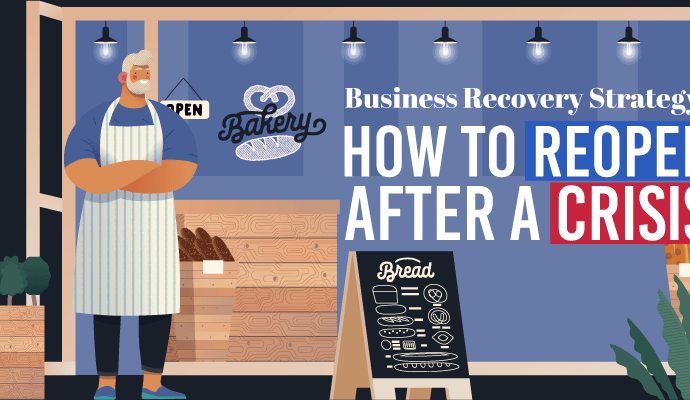Effects of the COVID-19 Pandemic on Philippin
Two years after the COVID-19 pandemic, a clear takeaway...




Signs reading, “Sorry we are temporarily closed,” were not uncommon during the start and peak of the COVID-19 pandemic. A survey showed that roughly 43% of small businesses that temporarily closed their doors were due to the pandemic.
Small businesses with limited financial resources were the most vulnerable, causing some to scale down or halt their operations until they find their rhythm back. Worse, many others were forced to shut down entirely due to the sharp drop in demand and revenue.
Ultimately, the COVID-19 pandemic revealed flaws in disaster recovery and business continuity plans, which explains why many businesses suffered from the situation more severely than others. Some small businesses don’t even have a continuity plan in place, forcing them to close down shop completely during the height of the crisis.
Certainly, the coronavirus will not be the last thing to put your business through the wringer. This is why you need to have contingency and recovery measures in place that will enable your business to weather and bounce back from crises.
If you’re unsure how to create a business recovery plan, you’ve come to the right place. This visual graph will help guide you through the recovery process.

Crunch the numbers to evaluate how deeply your business finances were affected by the crisis. Reviewing your cash flow and profit and loss statements is a good way to quantify exactly how much your business lost to the crisis. For instance, did you close temporarily? Did you lay off employees? Did you change suppliers or slash your marketing budget to cut costs?
You have to account for all the different ways your business was affected to put them into your rebuilding plan and know what to prioritize. This first step lets you forecast how much funds and resources you have left and how much more you’ll need to get back on track.
Your business plan, which you likely developed before the crisis, needs an overhaul to make sure you don’t experience the problem again.
During the COVID-19 pandemic, for example, most businesses worked out a strategy to continue their operations online because no one was coming to their physical store anymore. Many brick-and-mortar shops started offering delivery and pickup services to accommodate the shift in consumer demands and behavior.
This point also covers reshaping your strategy regarding operational risks. If the crisis was something your entire industry suffered, you can look at what your competitors did and how they adjusted to cope with the changes.
Consider exploring useful resources to help you better manage the challenges your business faces. Below are a few helpful resources to get you started:
You will need money to make money. Now that you have a better picture of your finances, calculate how much you’ll need to reopen your business and keep it running for several months until sales become stable. Consider the business aspects you’ll need to spend money on. This can include inventory you need to purchase, marketing expenses, or hiring and training costs for employees.
Since finances can be extremely tight during this phase, you can consider looking into funding options, such as the following:
You will need some time to generate enough revenue to sustain your operations, and you have to shell out a significant amount upfront to get your business running. With that, you must identify the most important aspects that need funding and distribute your budget appropriately.
For example, you can start with minimum operating expenses (e.g., workforce, location, inventory) and cut back or slow down on non-essential expenses (e.g., dispensable hardware). Keep in mind that your goal is to maximize your operating budget and eliminate unnecessary costs.
It takes a lot of groundwork to get your business rolling, especially in this atypical time. Take as much time as you need to create a timeline of what you need to accomplish for the relaunch. These tasks can include securing your funding, hiring or rehiring employees, evaluating and restocking inventory, setting up your online business profiles, planning for marketing, and the actual reopening.
This process can easily get overwhelming, causing you to get sidetracked by business activities that aren’t as important or urgent as others. Make sure to identify your priority actions—tasks that will deliver a solid return on investment. Perform a weekly check to monitor your progress and make adjustments if needed.
Your employees were also affected by the crisis, so they’re looking at you for assurance that they won’t have to suffer through a similar problem again. You need to give them the security they’re looking for to keep employee morale up, which is important to your day-to-day operations and business productivity.
Taking the COVID-19 pandemic as an example, there’s no doubt that many people are still terrified about getting infected when they go out in public or simply interact with other people. As a business owner starting to make changes in how you do business, you need to address this anxiety to ensure you operate properly in the new normal.
You need to show your employees that you’re taking the necessary precautions to ensure it’s safe to go back to work. Place safety protocols where customers can see what steps you’re taking to secure your place. Here are some steps you can take to reassure anxious customers and employees:
Unpreparedness can put a halt to your business operations. SMEs can learn from the COVID-19 pandemic when it comes to crisis management and identifying threats and outcomes.
You should consider all angles of your business, with particular attention to the badly hit aspects, to help deliberate on how you can prevent or minimize the damage of another crisis and continue your core business operations amid one. Use the lessons and experiences learned from the coronavirus crisis.
You can look into business contingency plan examples or guides to start. Make sure to review and update your business continuity plan to uphold its effectiveness and guarantee the continual improvement of your business processes, such as when an emergency occurs, or another surge of cases happens.
The coronavirus pandemic has stressed out and brought businesses of all sizes to the brink. Whether you’re reshaping your small business to move online or reinventing it for the long term, resilience, adaptability, and creativity are essential to recovering from such challenging times.
Seeking guidance from experts and financial lenders is worth considering to help take your business off the ground. If you require funding for business recovery, get in touch with JK Capital and inquire about small business loan application.
Two years after the COVID-19 pandemic, a clear takeaway...
For starting business owners, navigating the overwhelmi...